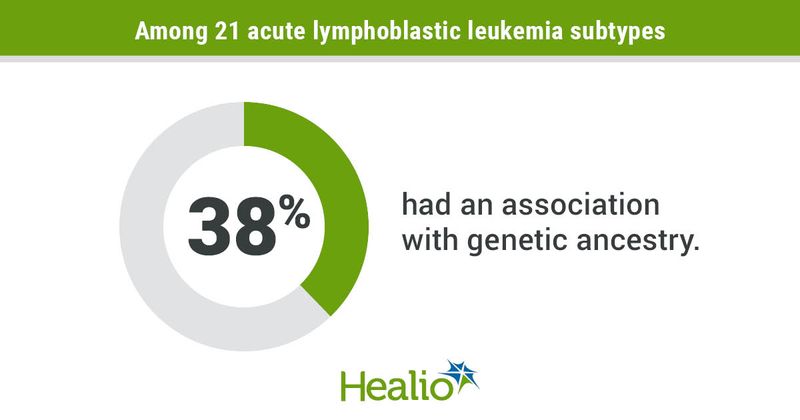Genetic ancestry associated with molecular subtypes, prognosis of childhood ALL
Acute lymphoblastic leukemia molecular subtypes and prognosis appeared associated with genetic ancestry, suggesting a possible genetic basis for racial and ethnic disparities in ALL, according to a study in JAMA Oncology.
“It is very clear that childhood ALL biology differs by genetic ancestry and this childhood cancer’s biology has a wide global diversity,” Shawn H.R. Lee, MD, postdoctoral research fellow, and Jun J. Yang, PhD, vice chair in the department of pharmacy and pharmaceutical sciences, both at St. Jude Children’s Research Hospital, told Healio in a joint statement.

“In the past, we have always extrapolated treatment protocols developed for white children (children of European descent) to other populations,” they continued. “In the era of personalized medicine, we have to develop biologically driven treatment protocols that also take this racial diversity into consideration and stop assuming that what works for white children will also work for children from other populations.”
Methodology
The analysis included 2,428 children and adolescents with ALL (mean age, 7.8 years; 57.8% male; 70.2% aged 1 to 9 years) from the U.S., Southeast Asia (Singapore and Malaysia) and Latin America (Guatemala) enrolled in front-line clinical trials between March 1, 2000, and Nov. 20, 2020.

Lee, Yang and colleagues performed RNA sequencing to comprehensively categorize molecular subtypes of ALL and genetic ancestry. They then evaluated associations of genetic ancestries with ALL molecular subtypes and treatment outcomes.
The researchers sought to characterize the diversity of ALL biology (ie, molecular subtypes) across different global populations and determine whether genetic ancestry impacts outcome, even with modern-day therapy.
Key findings
Results showed eight of the 21 identified ALL subtypes had an association with ancestry.
Within the individual populations, researchers reported:
East Asian ancestry had a positive association with somatic DUX4 (OR =1.3; 95% CI, 1.16-1.45) and ZNF384 (OR = 1.4; 95% CI, 1.18-1.66) gene rearrangements and a negative association with BCR-ABL1-like ALL (OR = 0.79; 95% CI, 0.66-0.92) and T-cell ALL (OR = 0.8; 95% CI, 0.71-0.9).
Native American ancestry had a positive association with CRLF2 arrangements (OR = 1.48; 95% CI, 1.29-1.69). ETV6-RUNX1 fusion became less frequent when the percentage of Native American ancestry increased (OR = 0.8; 95% CI, 0.7-0.91), with the opposite trend observed for ETV6-RUNX1-like ALL.
Children of African descent (OR = 1.22; 95% CI, 1.07-1.37) had a marked preponderance of T-cell ALL compared with those with a high percentage of Native American ancestry (OR = 0.53; 95% CI, 0.4-0.67).
African ancestry had a positive association with TCF3-PBX1 (OR = 1.49; 95% CI, 1.25-1.76) and a negative association with DUX4 rearrangements (OR = 0.7; 95% CI, 0.48-0.93; P = .01) and hyperdiploidy (OR = 0.77; 95% CI, 0.68-0.86).
As continuous variables, for every 25% increase in ancestry, African and Native American ancestries had an association with poorer EFS (African ancestry: HR = 1.2; 95% CI, 1.1-1.4; Native American ancestry: HR = 1.3; 95% CI, 1-1.6) and OS (African ancestry: HR = 1.2; 95% CI, 1.1-1.5; Native American ancestry, HR, 1.4; 95% CI, 1-1.8).
Native American and African ancestries remained associated with poor prognosis even after adjusting for biological subtypes and clinical features, the researchers wrote.

“While we expected to see some differences in ALL biology by genetic ancestry, we probably did not expect to see such clear differences across some of these new subtypes (for example, DUX4),” Lee and Yang told Healio.
Implications
The results may have simply scratched the surface on genetic ancestry’s association with ALL outcomes, according to the researchers.
“Our analyses were on the conservative side and may not have been powered to sufficiently detect differences for the very rare subtypes; hence, these differences in biology may be a lot more extensive than we know,” Lee and Yang told Healio.
They said next steps would include evaluating the genetic ancestry association among larger, global ALL cohorts, particularly in Asian and Middle Eastern countries.
“Overall, we would like to see racial diversity being placed front and center as a consideration in both clinical research and treatment of patients, with the goal of eliminating racial gaps in survival,” they said.
In an editorial that accompanied the study, Karen R. Rabin, MD, PhD, director of the leukemia program at Texas Children's Hospital and associate professor in the department of pediatrics in the section of hematology-oncology at Baylor College of Medicine, wrote that the study “lays a strong foundation for further investigation” but highlighted some areas lacking within the research.
“Although this study includes a commendable range of international trials and an impressive total number of participants, it nevertheless faces limitations of power owing to multiple comparisons among the many ALL subtypes and racial and ethnic categories, several of which have relatively small numbers,” Rabin wrote. “Another question requiring further study is how age may interact with genetic ancestry. The frequencies of ALL subtypes vary significantly with age, as do patient outcomes. The current study only included a small number of patients aged 18 to 30 years.”
References:
Lee SHR, et al. JAMA Oncol. 2022;doi:10.1001/jamaoncol.2021.6826
Rabin KR. JAMA Oncol. 2022;doi:10.1001/jamaoncol.2021.6785.
For more information:
Shawn H.R. Lee, MD, and Jun. J. Yang, PhD, can be reached at Department of Pharmaceutical Sciences, St. Jude Children’s Research Hospital, 262 Danny Thomas Place, Memphis, TN 38105; email Lee: shawn.lee@stjude.org; email Yang: jun.yang@stjude.org.
